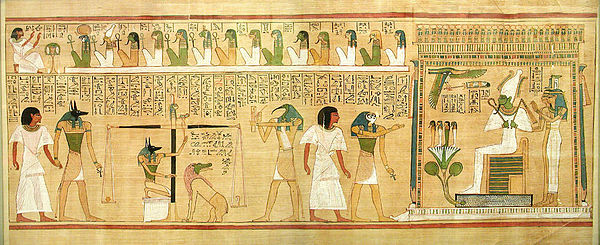The Book of the Dead was intended to assist the deceased in the afterlife and comprised a collection of hymns, spells and instructions to allow the deceased to pass through obstacles in the afterlife.
The "Book of the Dead" is the usual name given to the ancient Egyptian funerary text called the "Spells of Coming (or Going) Forth By Day." The Book of the Dead was most commonly written on a papyrus scroll and placed in the coffin or burial chamber of the deceased.
The Book of the Dead was the product of a long process of evolution starting with the Pyramid Texts of the Old Kingdom through the Coffin Texts of the Middle Kingdom. About one third of the chapters in the Book of the Dead are derived from the earlier Coffin Texts. The Book of the Dead itself was adapted into The Book of Breathings in the Late Period, but remained popular in its own right until the Roman period.
Versions
Single spells of the Book of the Dead are already known from the late Middle Kingdom. Many spells on the coffins of Sesenebnef or queen Mentuhotep are identical to later chapters of the Book of the Dead. During the New Kingdom The Book of the Dead was not organized or standardized in a set order. The texts appear to reflect the preferences of the individual or their family. This is known as the 'Theban Recension'. In the Third Intermediate Period leading to the Saite period, the Book of the Dead became increasingly standardized and organized into a set number of Spells or Chapters in a standard order and versions of this period are known as the 'Saite Recension'.
Saite recension
The Books of the Dead from the Saite period tend to organize the Chapters into four sections:
* Chapters 1–16
The deceased enters the tomb, descends to the underworld, and the body regains its powers of movement and speech.
* Chapters 17–63
Explanation of the mythic origin of the gods and places, the deceased are made to live again so that they may arise, reborn, with the morning sun.
* Chapters 64–129
The deceased travels across the sky in the sun ark as one of the blessed dead. In the evening, the deceased travels to the underworld to appear before Osiris.
* Chapters 130–189
Having been vindicated, the deceased assumes power in the universe as one of the gods. This section also includes assorted chapters on protective amulets, provision of food, and important places. There are 192 unique chapters known, and no single papyrus contains all known chapters.
Production
Books were often prefabricated in funerary workshops, with spaces being left for the name of the deceased to be written in later. They are often the work of several different scribes and artists whose work was literally pasted together. The cost of a typical book might be equivalent to half a year's salary of a laborer, so the purchase would be planned well in advance of the person's death. The blank papyrus used for the scroll often constituted the major cost of the work, so papyrus was often reused.
Images, or vignettes to illustrate the text, were considered mandatory. The images were so important that often the text is truncated to fit the space available under the image. Whereas the quality of the miniatures is usually done at a high level, the quality of the text is often very bad. Scribes often misspelled or omitted words and inserted the wrong text under the images.
Publication history
The name "Book of the Dead" was the invention of the German Egyptologist Karl Richard Lepsius, who published a selection of the texts in 1842. When it was first discovered, the Book of the Dead was thought to be an ancient Egyptian Bible. But unlike the Bible, the Book of the Dead does not set forth religious tenets and was not considered by the ancient Egyptians to be the product of divine revelation, which allowed the content of the Book of the Dead to change over time.
The earliest manuscripts were published in the aftermath of the Egyptian expedition led by Napoleon Bonaparte in "Description de l'Ėgypte" (1821). Jean Francois Champollion was one of the early translators. In 1842 Karl Richard Lepsius published a version dated to the Ptolomaic era and coined the name "Book of The Dead", a title not known or used by the Ancient Egyptians, as well as the chapter numbering system which is still in use. Samuel Birch published the first English version in 1867. Edouard Naville published what was to become the first full standard edition in three volumes (1886). Using the papyrus texts in the British Museum E. A. Wallis Budge published editions including the Papyrus of Ani, which Naville had not dealt with, in 1890. Peter le Page Renouf's English edition was published in parts beginning in 1892. Budge's hieroglyphic edition was published in 1898 and is still widely used. Budge's 1901 English translation is still in print. More recent translations in English have been published by T. G. Allen (1974) and Raymond O. Faulkner (1972)



~ data from Wiki


 留言列表
留言列表


 Video
Video